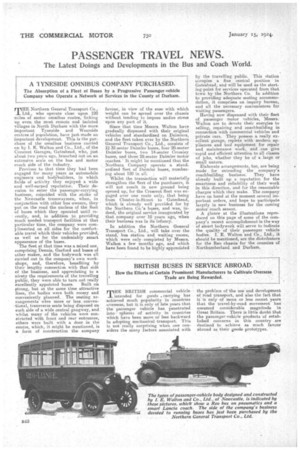BRITISH BUSES IN SERVICE ABROAD.
Page 24

Page 25

If you've noticed an error in this article please click here to report it so we can fix it.
How the Efforts of Certain Prominent Manufacturers to Cultivate Overseas Trade are Being Rewarded.
TBE BRITISH commercial vehicle. intended for goods . carrying has achieved much popularity in countries overseas, but it is only of late years that the passenger vehicle has penetrated into spheres of activity in countries which have been more or less backward in adopting mechanical transport. This is not really surprising when one conaiders the many factors associated with
the problem of the use and development of road transport, and also the fact that it is only of more or less recent years that the travel-by-road movement has assumed considerable magnitude in Great Britain. There is little doubt that the passenger-vehicle products of established concerns in this country are destined to achieve as much favour abroad as their goods prototypes.
John I. Thornycroft and Co., Ltd., have always devoted considerable atten, tion to the development of creelSeas trade, and their latest movements in this direction are indicated by the illustrations produced on this page, which show a single deck omnibus which has just been put into service by a Danish company in Copenhagen, where it is the first paraffin-propelled passenger vehicle to rim in Scandinavia.
The chassis is a Thornycroft B.T. 2-ton type, and it is identical with that which was awarded the Dewar Trophy by the Royal Automobile Club in 1921, except that the vehicle illustrated is equipped with giant pneumatic tyres. The engine is the standard Thornycroft 30 h.p. type AB/4, and it is fitted with the company's paraffin. vaporizer, which has been used with considerable success for many years past an the various models of marine engines produced in their works.
The vehicle has only been in service a few weeks, but in spite of the exceedingly cold climate, the engine has run extraordinarily well.
The saloon body incorporates many interesting features: which are not general practice on vehicles intended for service in this country. It was built by the Scandinavian branch of the Thornycroft Co., and provides accommodation for 20 passengers, the seats being disposed as shown in our illustration of
the interior. It is intended that the vehicle should carry a certain amount of luggage, and for this purpose "a grid is provided at the forward end of the body, a folding ladder giving access to the roof.
Certain other interesting features about the vehicle include a central heating apparatus which is intended to maintain the temperature of the interior at a comfortable degree, electric lighting (which includes lamps which reflect on the entrance and exit steps), a small coloured electric light immediately above the front of the body, which serves as a distinctive signal and gives intending passengers warning of the vehicle's approach, and a mechanically -operated device which enables the driver to signal his road intentions to overtaking vehicle-S. The form which the lastnamed device takes can be readily seen from one of the pictures.
Since the bus was put into service it has run about 140 km. daily and gives every satisfaction to its owners and to the public which it is intended to serve. It is, of course, a very great advantage to the owners that they have the backing of the Thornycroft 'branch in Copen liagen, for they are thus assured of full service facilities in order to maintain the vehicle in an efficient condition.
The very satisfactory record which the vehicle has achieved since it was put into service will undoubtedly lead to additional British vehicles finding their way into a country where mechanical transport is as yet in its infancy. It should perhaps be mentioned in passing that John I. Thornycroft and Co., Ltd., have supplied many buses for use abroad, and vehicles of this type are now running in India, Straits Settlements, Brazil, China, Australia, etc.






























